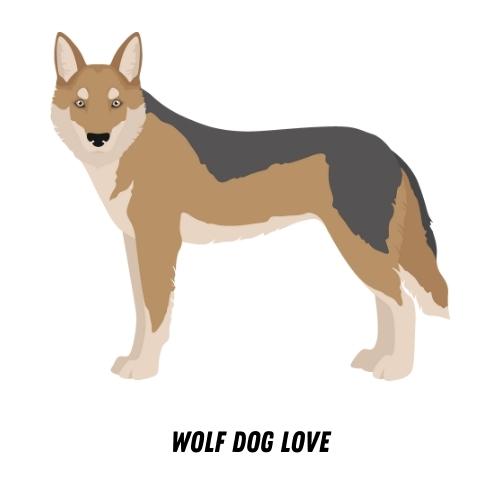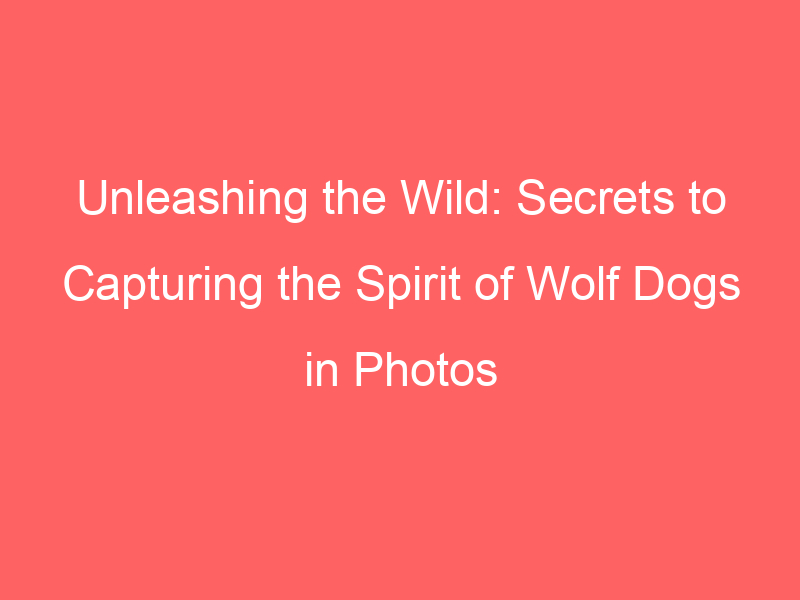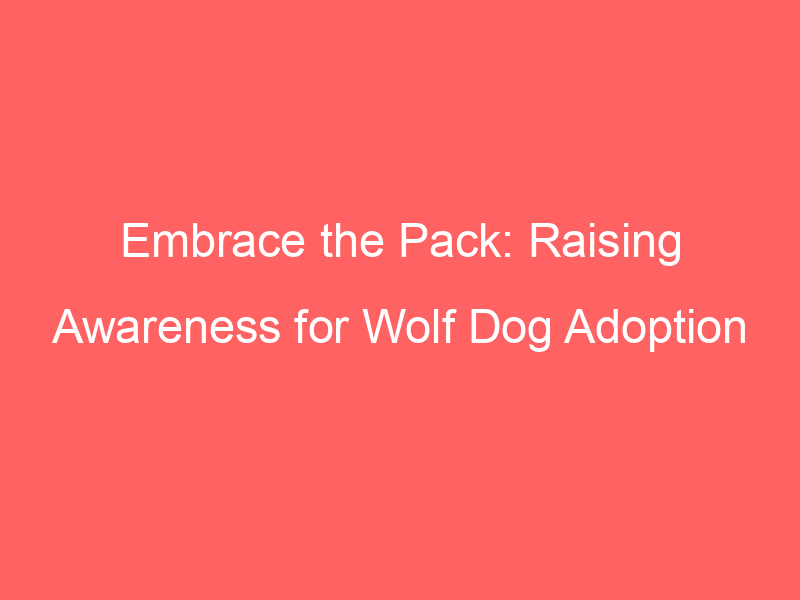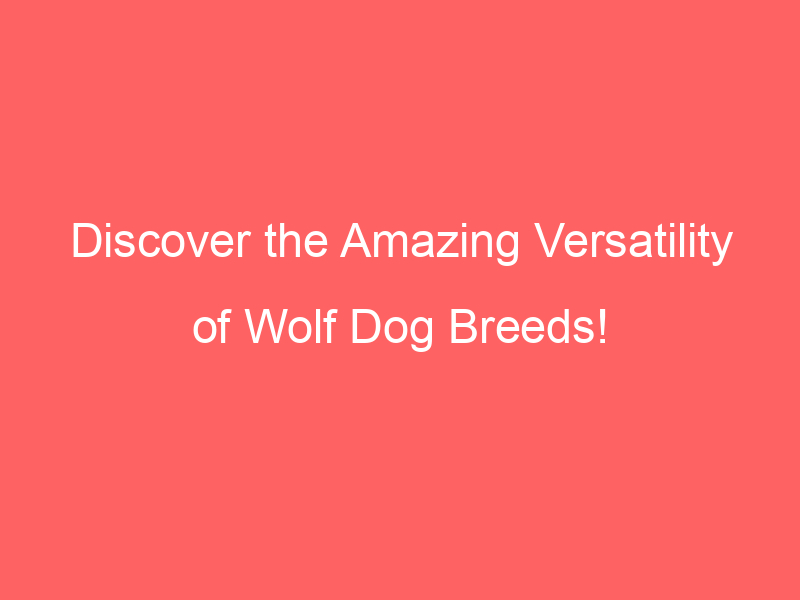Introduction to Wolf Dog Photography
Wolf Dogs, a unique blend of domestic dog and wild wolf, are creatures of exceptional beauty and complexity. Their captivating presence and mysterious aura make them a fascinating subject for photographers. This blog post will guide you through the essence of Wolf Dogs and the importance of capturing their images.
- Understanding the Essence of Wolf Dogs
- Importance of Capturing Wolf Dog Images
Wolf Dogs are not just ordinary pets; they are a symbol of the wild, embodying the raw power and grace of wolves, combined with the familiarity and loyalty of dogs. Their dual nature makes them intriguing subjects for photography. A Wolf Dog’s image can tell a story of survival, adaptability, and the blurred lines between the wild and the domestic.
Photographing Wolf Dogs is not just about creating stunning images; it’s about raising awareness and appreciation for these magnificent creatures. Each photograph can serve as a testament to their strength, beauty, and the important role they play in our ecosystem. By capturing their images, we can help educate others about Wolf Dogs, dispel myths, and promote their conservation.
Whether you’re a seasoned photographer or a beginner, understanding the essence of Wolf Dogs and the importance of capturing their images can enhance your photography skills. So, grab your camera, and let’s embark on this exciting journey of Wolf Dog photography together!
Photography Insights: Capturing the Wolf Dog Essence
Understanding the essence of a wolf dog is the first step to capturing their true nature in a photograph. Let’s delve into the behavior of these fascinating creatures.
Understanding Wolf Dog Behaviour
Wolf dogs are unique creatures, a blend of the wild wolf and domestic dog. To truly capture their essence, it’s essential to understand their behavior, which is influenced by their natural habitat and interaction with other animals.
- Studying their natural habitat
- Observing their interaction with other animals
Wolf dogs are most at home in the wild, where they can roam freely. Their natural habitat includes forests, mountains, and open fields. Observing wolf dogs in these environments can provide valuable insights into their behavior. For example, you might notice how they use their keen senses to navigate the terrain or how they communicate with other members of their pack.
Wolf dogs are social animals, often living in packs. Observing their interaction with other animals can reveal a lot about their behavior. They have a complex social structure, with each member of the pack playing a specific role. Noticing these interactions can help you anticipate their actions, allowing you to capture stunning, natural photographs.
Understanding wolf dog behavior is a crucial part of wildlife photography. By studying their natural habitat and observing their interactions, you can gain a deeper appreciation of these magnificent creatures and capture photographs that truly reflect their essence.
Professional Wolf Dog Photography Techniques
Photographing wolf dogs is a unique experience that requires a blend of skill, patience, and the right equipment. Here, we’ll explore three key techniques that can help you capture stunning photos of these magnificent creatures.
- Choosing the Right Equipment
When it comes to wolf dog photography, your equipment can make or break your shots. A high-quality DSLR or mirrorless camera is a must. Look for one with a fast autofocus system to capture sharp images of these fast-moving animals. A lens with a long focal length, such as a 70-200mm or 100-400mm, can help you maintain a safe distance while still getting close-up shots. Don’t forget about a sturdy tripod to keep your camera steady!
- Setting Up the Perfect Shot
Wolf dogs are naturally active and curious, so capturing the perfect shot involves a bit of planning. Try to position yourself at their eye level to create a more intimate and engaging photo. Pay attention to the background too. A clean, uncluttered background will help your subject stand out. If possible, use natural light to your advantage. Early morning and late afternoon light can add a beautiful, warm glow to your photos.
- Timing and Patience
Patience is perhaps the most important quality a wildlife photographer can have. Wolf dogs, like all animals, are unpredictable. You might spend hours waiting for the perfect shot, only to have it happen in a split second. Be ready to capture that moment when it comes. Remember, the best shots often come from unexpected moments, so keep your camera ready and your senses alert.
In conclusion, photographing wolf dogs can be a challenging but rewarding experience. With the right equipment, a well-planned shot, and a bit of patience, you can capture stunning images that truly reflect the essence of these magnificent creatures.
Animal Photography Tips: Focusing on Wolf Dogs
Wolf dogs are majestic creatures that make for stunning photography subjects. However, capturing their true essence requires a keen understanding of lighting and composition. Here are some tips to help you get started.
Lighting and Composition
Lighting and composition are two fundamental aspects of photography. They can make or break your image. When photographing wolf dogs, these elements become even more crucial.
- Utilizing Natural Light
- Composing a Balanced Image
Natural light is a photographer’s best friend. It can bring out the rich tones in a wolf dog’s fur and create a sense of depth and dimension in your images. The golden hours, early morning and late afternoon, are the best times to photograph. The soft, warm light during these times can add a magical touch to your photos.
Composition refers to the arrangement of elements in your photo. A well-composed image is balanced and pleasing to the eye. When photographing wolf dogs, try to include elements of their natural environment in the frame. This can create a sense of context and tell a more compelling story.
Remember, the rule of thirds can be a useful guide, but don’t be afraid to break it if it means capturing a more interesting shot. The key is to experiment and find what works best for you and your subject.
Photographing wolf dogs can be a rewarding experience. With the right lighting and composition, you can create images that truly capture the spirit of these beautiful creatures.
Post-Processing Techniques
After capturing the perfect shot of a wolf dog, the next step is to enhance the image through post-processing techniques. These techniques can help to improve the clarity of the image, enhance the contrast, and add mood to the photo through color grading.
- Editing for Clarity and Contrast
Editing for clarity and contrast is a crucial step in post-processing. It helps to bring out the details in the photo and make the wolf dog stand out against the background. This can be done using photo editing software like Adobe Photoshop or Lightroom.
For clarity, you can adjust the sharpness of the image to make the details of the wolf dog more visible. For contrast, you can play with the highlights and shadows to make the wolf dog pop out from the background. Remember, the goal is to make the wolf dog the main focus of the image.
- Enhancing the Mood with Color Grading
Color grading is another important post-processing technique. It involves changing the colors in the photo to create a certain mood or atmosphere. For example, you can use warm colors like orange and yellow to create a cozy and inviting mood, or cool colors like blue and green to create a calm and serene mood.
When photographing wolf dogs, you might want to use earthy colors like brown and green to match their natural habitat. Or, you can use contrasting colors to make the wolf dog stand out. The choice of colors can greatly affect the mood of the photo, so choose wisely.
In conclusion, post-processing is an essential part of wolf dog photography. It allows you to enhance the image and add your personal touch to it. So, don’t skip this step and take your time to perfect your photo.
Case Studies: Successful Wolf Dog Photo Techniques
In this section, we will delve into some real-life examples of successful wolf dog photography. We will explore the background, challenges, and outcomes of each shoot, providing valuable insights for aspiring photographers.
Case Study 1: Capturing the Alpha
Our first case study focuses on the challenging task of capturing the alpha, the leader of the wolf dog pack.
- Background of the shoot: The shoot took place in a natural forest setting, where a pack of wolf dogs resides. The aim was to capture the alpha in its natural habitat, showcasing its majestic and commanding presence.
- Challenges faced and solutions implemented: One of the main challenges was the alpha’s natural wariness and alertness, making it difficult to get close. The photographer used a long lens to maintain a safe distance, and patiently waited for the perfect moment when the alpha was relaxed and unguarded. Additionally, the lighting conditions in the forest were tricky, but this was overcome by using a reflector to balance the light and shadows.
- Final image and reception: The final image was a stunning portrait of the alpha, standing tall and proud against the backdrop of the forest. The image was well-received, garnering praise for its composition, lighting, and the powerful portrayal of the alpha’s personality.
This case study demonstrates that patience, adaptability, and a deep understanding of the subject are crucial for successful wolf dog photography.
Case Study 2: The Playful Pup
Our second case study focuses on a playful wolf dog pup. This particular shoot presented its own unique challenges and rewards, as we aimed to capture the essence of youth and playfulness in a wild creature.
- Preparation for the Shoot
- Techniques Used to Capture the Essence
- Outcome and Lessons Learned
Preparing for this shoot required a different approach. We needed to create an environment where the pup could feel comfortable and playful. We used a wide, open space with plenty of toys and distractions. The aim was to capture the pup in its natural playful state, so patience was key. We spent several hours observing and interacting with the pup to make it comfortable with our presence.
To capture the essence of the playful pup, we used a variety of techniques. We used fast shutter speeds to capture the quick movements of the pup. We also used a wide-angle lens to capture the pup’s environment and show it in context. We made sure to shoot at the pup’s eye level to capture its perspective. The use of natural light was crucial in highlighting the pup’s youthful energy and playful nature.
The outcome of the shoot was a series of vibrant, dynamic photos that truly captured the essence of a playful wolf dog pup. The images were well-received, with many praising the authenticity and energy of the photos.
One of the key lessons we learned from this shoot was the importance of patience and adaptability in animal photography. Every animal is unique and requires a different approach. In this case, allowing the pup to play and interact with its environment naturally led to the most authentic and engaging photos.
| Key Takeaways |
|---|
| Patience and adaptability are crucial in animal photography. |
| Using a variety of techniques can help capture the essence of the subject. |
| Preparation is key to creating a comfortable environment for the animal. |
Conclusion: The Art of Wildlife Photography
As we draw the curtains on this enlightening journey into the world of wolf dog photography, it’s essential to reflect on the key insights we’ve gathered. The art of wildlife photography, particularly focusing on wolf dogs, is a rewarding and enriching experience that requires patience, skill, and a deep understanding of these magnificent creatures.
- Recap of key takeaways
- Encouragement for aspiring animal photographers
Throughout this article, we’ve explored various aspects of wolf dog photography. We started with an introduction to the subject, delving into the unique characteristics of wolf dogs that make them fascinating subjects for photography. We then moved on to discuss the essence of capturing these creatures in their natural habitat, highlighting the importance of patience, timing, and understanding their behavior.
We also shared valuable tips on focusing on wolf dogs, emphasizing the need for a good camera, the right settings, and the perfect timing. We further enriched our discussion with case studies of successful wolf dog photo techniques, illustrating how these tips can be applied in real-life scenarios.
If you’re an aspiring animal photographer, remember that every great photographer started somewhere. The road to mastery may be long and challenging, but it’s also filled with opportunities for growth and learning. Don’t be discouraged by initial setbacks; instead, view them as stepping stones towards your ultimate goal.
Wolf dog photography, like any other form of wildlife photography, requires a deep passion for animals and a commitment to understanding them. So, keep exploring, keep learning, and keep shooting. Your passion and dedication will undoubtedly shine through your work, creating stunning images that capture the true essence of these magnificent creatures.








